Issue: 5/05
Radiant heat is the plumbing and mechanical industry's highest life form. Let's face it-there's no other system that offers so much in terms of comfort, efficiency and flexibility.
When architects, builders or building owners state their need for a radiant or snowmelt system-or even a turf conditioning system, as the case may be-there are very few conditions that a design engineer can't meet. Intuitively, you ask: What's the purpose? What's the envelope? Outdoor conditions? Heat source? Btus required to get the job done? Solar gain?
When the essentials are known, that's when design engineering becomes more like an art form. The engineer considers various system elements and techniques, applying them as a master artist chooses colors for the canvas, though this canvas is on a somewhat grander scale. It might be:
- A high mass or low mass slab (at grade, below grade, suspended)
- Walls of all description
- Floors (slabs, joist bay, above subfloor)
- Ceilings (Can't get enough Btus into the floor or wall?)
- Tub-surrounds, showers, countertops, etc.
- On the outside"
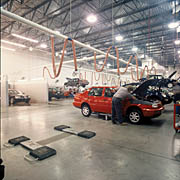 The maintenance bays at York Volkswagen, Inc. in York, PA, are warmed with a radiant heating system.
The maintenance bays at York Volkswagen, Inc. in York, PA, are warmed with a radiant heating system.Fahrvergnugen!
Remember Volkswagen's Fahrvergnugen campaign? Translated, it means "driving with zeal."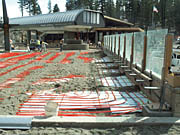 Mammoth Mountain Ski Resort near Yosemite Valley, CA, features 125,000 square feet of snowmelted surface in its common areas.
Mammoth Mountain Ski Resort near Yosemite Valley, CA, features 125,000 square feet of snowmelted surface in its common areas.A Mammoth Challenge
Think you've got it tough in the winter? At Mammoth Mountain ski resort near Yosemite Valley in Central California, they get an average of 32 feet of snow each year, with temperatures as low as minus 20"Whether it's under brick pavers, concrete slabs, broad stairways, or in elevated walkways between buildings, we designed-in miles of radiant heat tubing for melting snow,"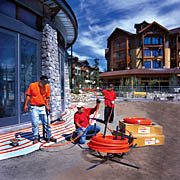 Mammoth Mountain Ski Resort near Yosemite Valley, CA, features 125,000 square feet of snowmelted surface in its common areas.
Mammoth Mountain Ski Resort near Yosemite Valley, CA, features 125,000 square feet of snowmelted surface in its common areas.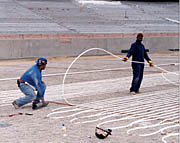 Gillette Stadium in Foxboro, MA, features a radiant turf warming system that uses 153,000 lineal feet (29 miles) of PEX tubing to warm the soil.
Gillette Stadium in Foxboro, MA, features a radiant turf warming system that uses 153,000 lineal feet (29 miles) of PEX tubing to warm the soil.Super-Size It
One of the newest and most advanced turf conditioning systems is now hard at work under the field at Foxboro's Gillette Stadium, home to the New England Patriots. According to the Patriots' field superintendent, the application of technology to enhance turf performance has "finally come of age." The W Hotel group’s Beach Bar in San Diego, CA, is a 2,000-square-foot, open-air lounge on 12 inches of radiant-heated sand.
The W Hotel group’s Beach Bar in San Diego, CA, is a 2,000-square-foot, open-air lounge on 12 inches of radiant-heated sand.A Radiant Sandbox?
The W Hotel group's San Diego facility offers its trendy club-hoppers a warm beach retreat-60 feet and five stories above sea level. The Beach Bar is a 2,000-square-foot, open-air lounge on 12 inches of luxuriously heated sand.The radiant system consists of several layers. Above the reinforced structural slab, tilted at a slight pitch for drainage, are several layers of rigid foam insulation and a waterproof membrane. A lightweight concrete slab, 2-1/2 inches thick, contains the EPDM rubber radiant heat tubing, and the sand sits on top of that. The slab sensor sits in a waterproof metal container for easy access.
The target temperature? Between 80 and 85 degrees, which means an average temp of 100
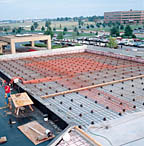 St. John’s Hospital in Springfield, MO, upgraded its helicopter landing areas to include two rooftop pads with snowmelting in all exposed surfaces.
St. John’s Hospital in Springfield, MO, upgraded its helicopter landing areas to include two rooftop pads with snowmelting in all exposed surfaces.A Rooftop Roost for Helicopters
When St. John's Hospital in Springfield, MO, made improvements for helicopter landings last year, they went from one to two rooftop pads and turned all exposed surfaces into snowmelt areas. The six radiant zones, tied to the hospital's central steam plant through a steam-to-water/glycol heat exchanger, warm 44,000 lineal feet of 5/8-inch radiant PEX tubing and a total rooftop area of 20,370 square feet.One of the precautions taken by the design engineers was to warm all surfaces on the rooftop. While not providing complete surface heat would have saved on the fuel bill, it could not guarantee that landings or take-offs wouldn't whip-up a windstorm of flying, icy projectiles.
All rooftop areas, gangways, and roof edges are heated to around 36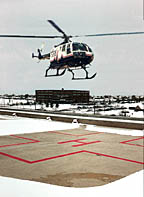 The six radiant zones at St. John’s Hospital warm 44,000 lineal feet of 5/8-inch radiant PEX tubing and a total rooftop area of 20,370 square feet.
The six radiant zones at St. John’s Hospital warm 44,000 lineal feet of 5/8-inch radiant PEX tubing and a total rooftop area of 20,370 square feet.